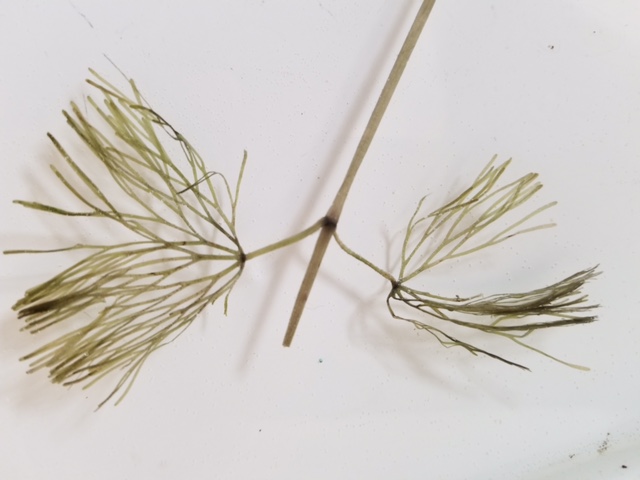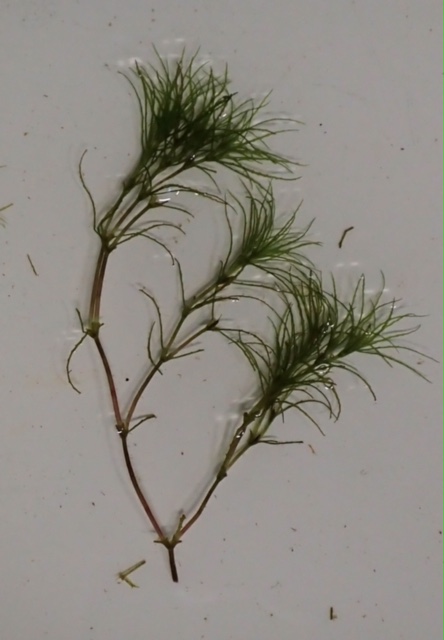by Mary Jewett – LEA teacher/naturalist • this article reprinted with the permission of LEA
My primary job during the summer is to manage the Courtesy Boat Inspection (CBI) program for the Lakes Environmental Association (LEA). The goal of this summer job is to prevent the spread of Invasive Aquatic Species (IAS) into and between Maine’s lakes. Over the last several years I have been deeply involved with the IAS programs throughout the state. Several state, local, and non-profit groups have worked together to develop a strong prevention program, but there is definitely more to do.
There are so many parts to this issue that I sometimes get overwhelmed, but I want to focus on a particular topic that has come across my radar a lot this past summer. The problem is so simple, but many people don’t know: it’s not just milfoil!
I often hear people, including avid boaters and lake protectors, saying “I know what milfoil looks like, so I won’t spread it”. This mindset needs to change. There are 11 invasive plants on the Department of Environmental Protection’s list of “most unwanted” in Maine, and only two of them are milfoils.

Fanwort 
The two lakes in Maine that have European Naiad (shown above) are lake arrowhead and northeast pond
As someone who works with this subject every day, I can tell you my biggest concern right now: European Naiad, also known as Brittle Waternymph. This plant is found in two waterbodies in Maine and is sneakier and more aggressive than our two invasive milfoils. The reason I say sneaky, even though that is a weird way to describe a plant, is because European Naiad produces seeds, lots and lots of tiny seeds. Seeds so small that a boater might not even be able to see them on their gear. It is important that boaters take extra care in lakes with naiad, washing your boat after leaving, especially if you are headed to a different lake. I’ll even make it easy for you. The two lakes in Maine that have European Naiad are Lake Arrowhead and Northeast Pond. Please take extra precautions when leaving those places or, better yet just avoid them altogether.
My point with this article isn’t to try to teach everyone what all the invasive plants in Maine look like. I just want everyone, boater or not, to understand that there are several invasive plants, and animals, that you never hear about. It’s not just milfoil!
There are 11 invasive plants on the Department of Environmental Protection’s list of “most unwanted” in Maine, & only two of them are milfoils.
The Maine Milfoil Law (a ridiculous title, considering the point of my article) states that it is illegal to transport ANY aquatic plant over land on your boat or trailer. The reason they said any plant is because the state doesn’t expect anyone to know what all the invasive plants look like – we just want you to remove plants from your gear between launch sites.
The Courtesy Boat Inspectors at local boat ramps are there to help out, and act as a reminder to inspect your own boat, but they should not be the only line of defense. If there isn’t an inspector at a boat launch (hint: there usually isn’t!) then boaters need to do their own inspection.
If you are interested in knowing more about the different invasive plants in Maine (and the ones we are actively trying to keep out) visit the LEA website: www.mainelakes.org or email me: mary@mainelakes.org.
Finally, I’ll acknowledge that this “Earth Notes” article sounds an awful lot like a push for the work we do at LEA. But I assure you that the topic discussed here is personal to me and applies to all of us who care about protecting our lakes.
Mary Jewett, teacher/naturalist, graduated from Unity College with a bachelor’s degree in science ecology in 2006. Mary’s early career at LEA began in high school when she volunteered to help with the water testing program during one summer. Since then, her volunteer work has led her to focus on diverse environmental topics. Mary worked for a summer at Avian Haven in Freedom, Maine where she helped in the rehabilitation of wild birds. She also completed a prior term of AmeriCorps service in Cherokee, North Carolina where she used field research to determine the fire risk on the Cherokee reservation. Mary has a passion for education and believes that her own feelings about the natural world inspire others to care about it too.
